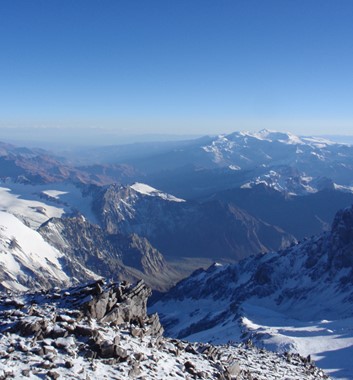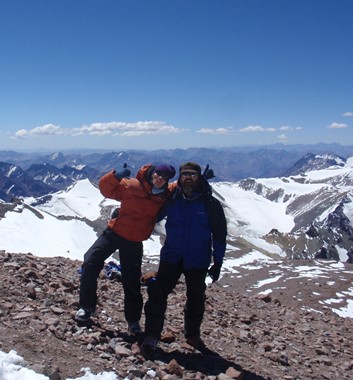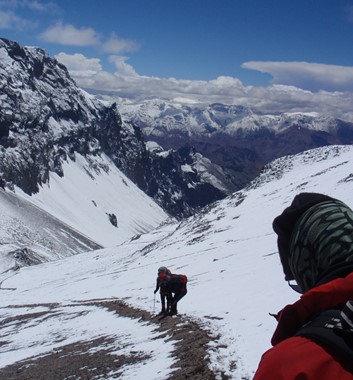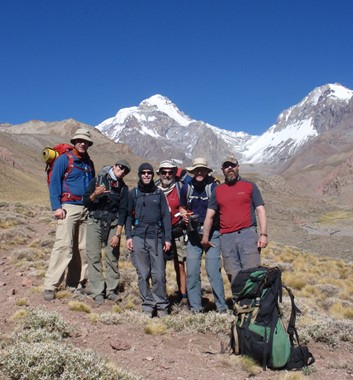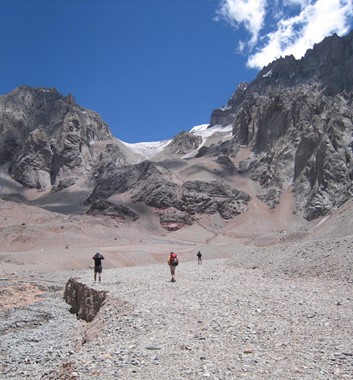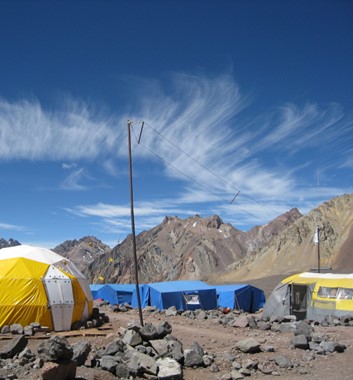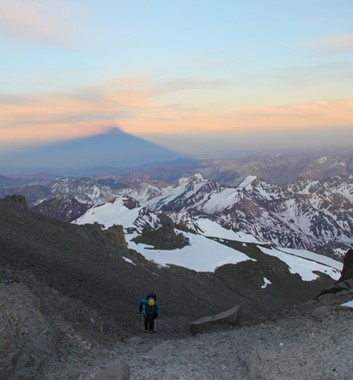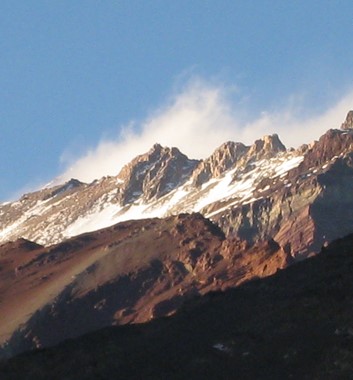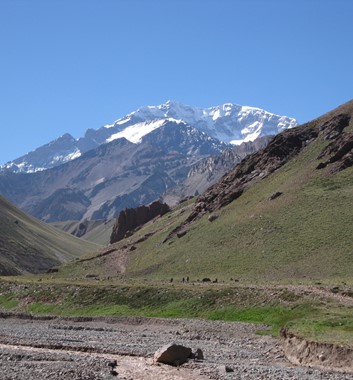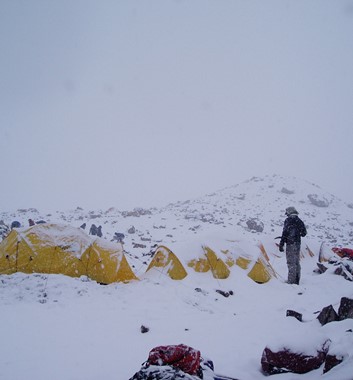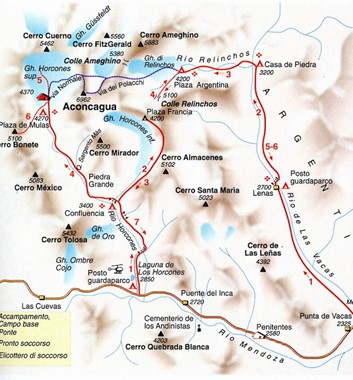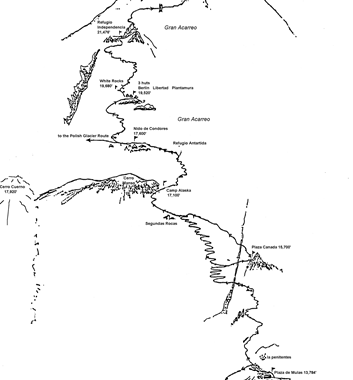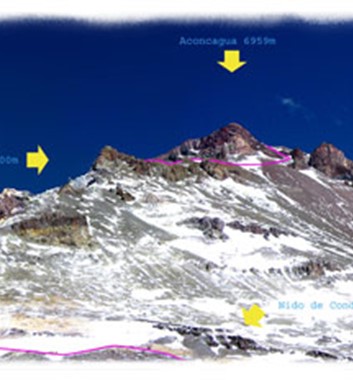Overview
Mount Aconcagua Horcones Valley Route (North)
Much of the hiking is on scree and rock. Although there are no permanent snowfields, crampons and ice axe are still required for the higher sections. Sometimes the final few hundred metres is covered with ice and snow which is much easier to crampon up, than having to walk up on loose scree after a dry winter.
Walk in
The route for the Horcones Valley on Aconcagua starts from the road at Puente Del Inca with a two day walk up the Horcones Valley (stopping at Confluencia along the way to acclimatise), a long and dry valley all the way to Plaza del Mulas. The weather can be very extreme, either very hot and dusty or with the potential for snow, wind, hail and storms. The route has stunning views of surrounding peaks and cliffs, with dramatic striations and colours especially with the setting sun on them.
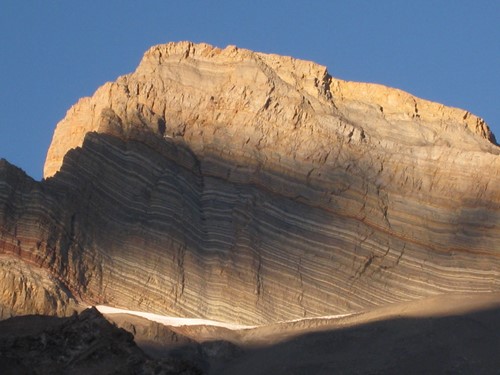
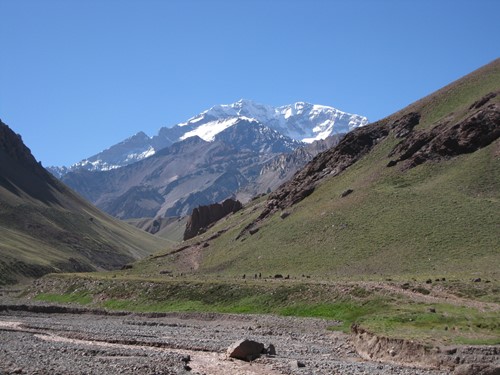
We use mules to take all the gear to this point and stay overnight at Confluencia Camp for two nights. The third day’s walk to base camp takes a whole day and it is tough. It is not uncommon to feel dehydrated, tired and slightly altitude sick on reaching Plaza del Mulas (4200m).
At base camp, there is little or no vegetation, and it is dry and cold with temperatures ranging from -15 to +15 degrees Centigrade. Here we put up our tents and use local base camp services for meals, toilets and showers. There are charging facilities and a free medical service.
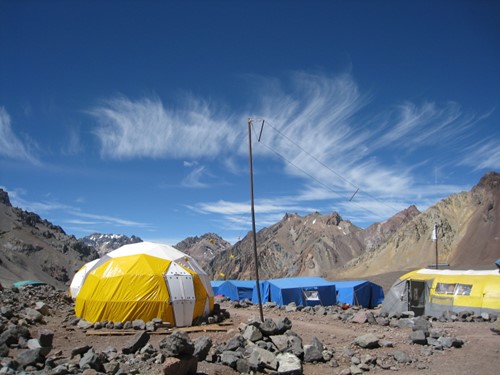
Base Camp to Camp Canada is about four hours to 5000 metres on a long easy scree slope with a zigzag path. We have to manage some carries of food, gas and equipment.
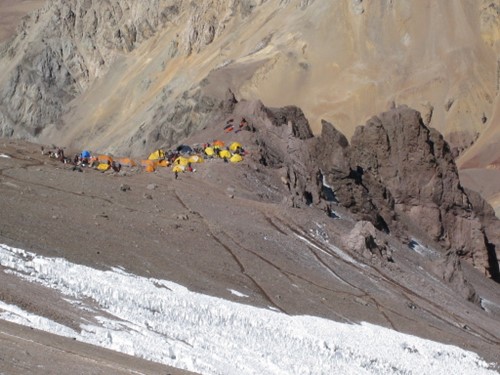
Camp Canada to Nido de Condores is about four hours to 5400 metres on scree and snow with a path. We will have to stock this camp with food, gas and tents. Nido can be very windy with deep snow. Decisions on summiting are made here since above this camp our supplies will be limited.
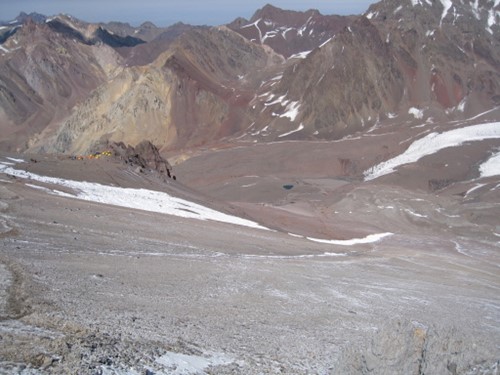
Nido de Condores to Berlin Camp is about four-hour hike to 5940 metres, on rock and snow. Everything required for summit day will be carried up in one load normally, so heavy rucksacks are normal. Another option is to hike a little further to Camp Colera (5980m) which is a little more exposed but has more space. This is a dramatic place to camp with exceptional views over the Andes. We try hard to get some rest, liquids and food into us before attempting to reach the summit.
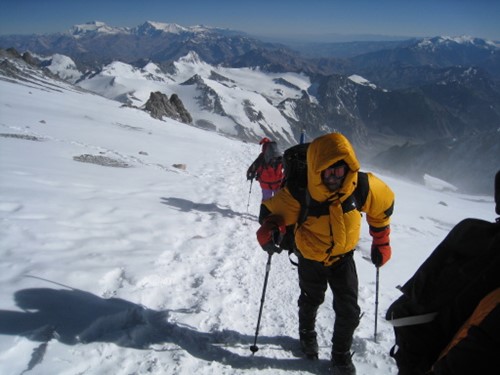
Normally summit morning begins at about 3 am. Berlin Camp or Camp Colera to the summit is about 8 - 10 hours to 6962 metres on rock, snow and ice, and then about 3 - 4 hours descent back to camp. Summit day is long and hard, very taxing on energy and a considerable achievement. It is always cold and windy and great effort must be put into looking after yourself. This is not a place for cheap equipment.
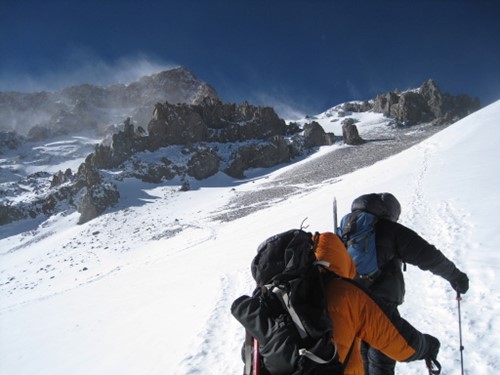
There are several sections to the summit route, starting with an initial ascent on the mixed ground up to White Rocks at 6100 metres. From here there are fine views over the Polish Glacier and a long set of zigzags on the exposed ground leading up to the Independencia Hut. By now the sun will be up, and the wind and cold can be savage.
There is then a long, low rising traverse to the base of the Canaleta, a 400m steep ascent on a mixture of scree and snow, and then a traverse to the Cresta del Guanaco just below the summit.
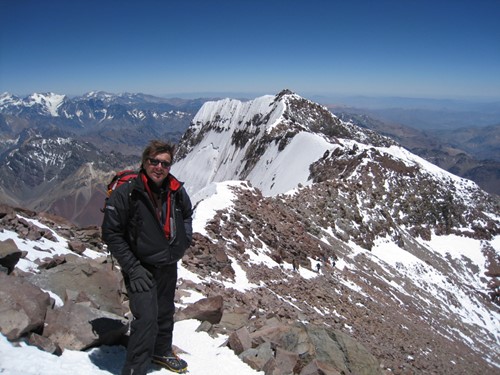
From here it is another 30 minutes to the summit itself which is quite large; normally spend about 20 minutes on the top taking photos.
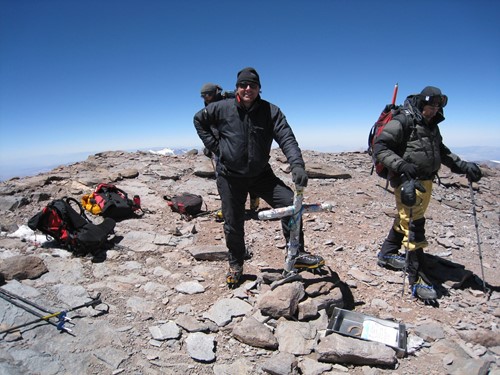
The descent back to base camp at Plaza del Mulas is over two days. Either sleep again at the top camp after the summit attempt and the next morning return to Nido de Condores to pick up the remaining gear and brave a very heavy rucksack back down to base camp. Or pack up the tent and get down to Nido straight away, and descend to base the next morning.
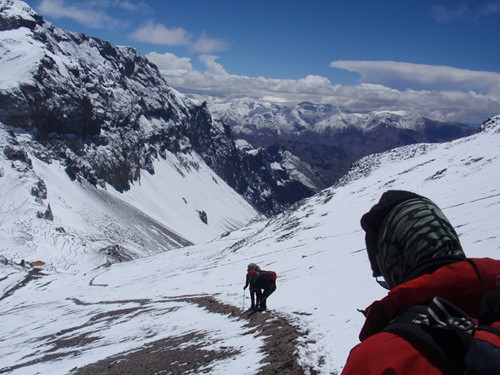
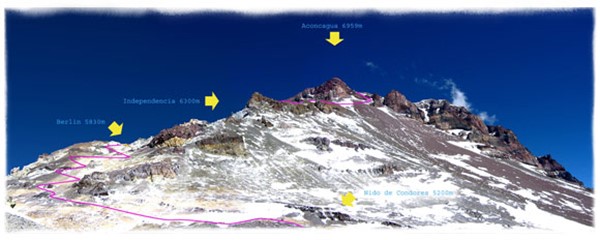
GPS Co-ordinates for the Horcones Route
The 1:40,000 map ‘Cerro Aconcagua’ (ISBN 978-3-9523294-0-5) is compatible with GPS and uses the WGS84 co-ordinating system. You can buy it online from Climbing Map for about €17.50. Below are the GPS coordinates for the main places visited on the Horcones Route and summit day.
|
Site description |
Altitude |
Latitude |
Longitude |
|
Puente del Inca |
9,020 - 2.750 |
32º 49.47' |
69º 54.69' |
|
Confluencia |
10,990 - 3.350 |
32º 45.56' |
69º 58.29' |
|
Plaza de Mulas, lower |
13,450 - 4.100 |
32º 39.65' |
70º 03.52' |
|
Plaza Mulas camp |
14,440 - 4.400 |
32º 38.92' |
70º 03.45' |
|
Plaza Canada |
16,670 - 5.080 |
32º 38.71' |
70º 02.62' |
|
Nido de Condores |
18,330 - 5.590 |
32º 38.24' |
70º 01.81' |
|
Berlin Refuge |
19,600 - 5.970 |
32º 38.32' |
70º 01.30' |
|
Camp Colera |
19,680 - 6.000 |
32° 38.25' |
70° 01.11' |
|
White Rocks – summit day |
20,010 - 6.100 |
32º 38.42' |
70º 01.12' |
|
Black Rocks – summit day |
20,360 - 6.210 |
32º 38.49' |
70º 00.96' |
|
Refuge Independencia |
21,000 - 6.400 |
32º 38.77' |
70º 00.93' |
|
The Finger - traverse |
21,290 - 6.490 |
32º 38.92' |
70º 00.95' |
|
The Cave – base of Canaleta |
21,940 - 6.690 |
32º 39.24' |
70º 00.95' |
|
Cresta del Guanaco |
22,400 - 6.830 |
32º 39.27' |
70º 00.86' |
|
Summit |
22,841 - 6.962 |
32º 39.19' |
70º 00.72' |
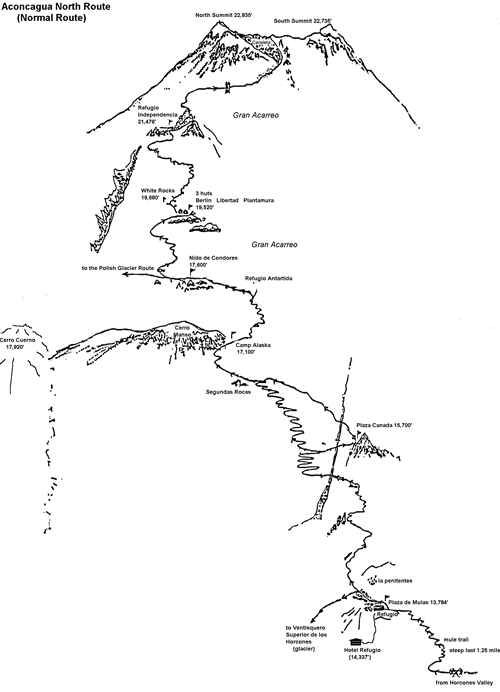
Mount Aconcagua broad plan
| Day | Elevation | ||
|---|---|---|---|
| 1, 2 | 750m | Arrive Mendoza. Get mountain permits and final packing of kit, kit rental is available. | |
| 3 | 2750m | Bus to Puente del Inca (near the entry to the Park) and overnight in roadside village. | |
| 4 | 4100m | Trek to Concordia Camp and camp for two nights, visit Plaza Francia | |
| 8-12 | 4100m - 5400m | Carries to high camps at 5000m and 5500m, acclimatising and rest days. Sleeping back at base camp. | |
| 13-17 | 4200m - 6962m | Summit cycle period with overnights at 5400m and 5980m, and two potential summit days. | |
| 18-19 | Return to trailhead and back to Mendoza. Hotel overnight. |
We always make sure that the first five days involve carries but sleeping low at base camp eating and sleeping well, followed by a summit cycle that allows a few nights at about 5500 metres and then some flexibility for going to the final camp and the Aconcagua summit.
How fit do I have to be to climb Aconcagua?
You will need to be in good physical condition. If you have not been to altitude before you must consider that 7000 metres is very high and you will need to monitor your ability to acclimatize, which will require patience and good judgment. Atmospheric pressure is 40% of sea level at the summit but people do not generally use supplemental oxygen for this expedition. Good physical fitness will aid your ability to trek at high altitude and carry a rucksack, assisting your body with it's acclimatisation, and it will of course make the trip more fun if you are not constantly feeling defeated by the demands of the trip.
Train the thigh and calf muscles, and work on lots of stamina training, cardio-vascular work and as much hill walking with a rucksack as possible. You cannot train for altitude anywhere in the UK or Ireland, so concentrate on arriving with the confidence of feeling fit and mentally prepared. Put on a little weight in the weeks beforehand and don’t over-train in case you strain something!
A gradual approach to training, several hours per week in the gym with a good walk on the weekend, will suffice. Pilates is excellent preparation, as is swimming, step machines, rowing and walking up stairs or hills. Practise also sleeping on hard surfaces since for some people the shock of lying on rock and ice in a tent can lead to sleepless nights. Sleeping tablets are strongly discouraged on a mountain trip because they slow down the rate of breathing, so it is important to give your body the best opportunity to rest. Work on feeling comfortable with a day hike and carrying a rucksack of around 15 kilos. It is also important to get your feet hardened and ready for the trek, since blisters will stop you faster than anything. Remember also that double boots or plastic mountaineering boots are quite heavy and stiff, so practise with them on and comfortable with a pair of thick mountain socks.
Note that members now need to undergo two medical examinations at base camp before being allowed to ascend higher. We strongly recommend that you have a medical before leaving home and discuss with us any pre-existing conditions such as high blood pressure or a heart murmur, which might affect this requirement by the Park Rangers. They do have the power to prevent you from climbing any higher, however in our experience they are very friendly and encouraging and they will help wherever they can to assist with a safe ascent. They do not condone the use of drugs like Diamox, unless needed in an emergency, preferring to advise on diet and a healthy lifestyle at base camp. So for example they will advise against taking salt in your meals.
Hiking on Mount Aconcagua
Much of the hiking is on scree and rock. Although there are no permanent snow fields (not including the glaciers, which are technical routes), crampons and a walking axe are still required for the higher sections. Sometimes the final thousand metres of elevation is covered with snowfall which can be consolidated into hardpack or ice, and any person contemplating Aconcagua should be prepared for extremely cold conditions and the need for using equipment competently. This means walking safely on crampons and knowing how to use an axe to arrest a slip, and using poles efficiently.
Summit day is a big mountaineering day, but the terrain never requires highly technical skills. It is a long hard ascent, and there is considerable exposure to the elements and of course to the altitude. The weather patterns will determine if you spend the day mostly on snow, ice or rock, but expect everything and be prepared with correct warm clothing and good double boots.
The most infamous feature to overcome is the Canaleta, which is a gully choked with boulders that is quite unremitting and hard work. Sometimes you will be on rock, other times it will be covered in snow and often is it hardpack and ice, but either way it is important to watch your feet and be able to move safely on crampons. Coming out of the gully, the route traverses the top of a large amphitheatre and ends up on the final ridge to the summit, with classic views over the south face. There is a bit of scrambling to the summit, but it is not difficult.
As ever, the issue will be keeping enough strength in hand to handle the descent safely. It is a long way down! But with adequate supplies of food, hot drinks in a thermos, warm clothes and a back up of safety gear like a sleeping bag for the group, group shelters and a stove for making a brew, everyone should be fine.
Camps on Mount Aconcagua
Vacas Valley route camps
Base Camp at Plaza Argentina is well facilitated and safe. There are huts for eating, medical facilities where everyone needs to get their permit stamped to show they are medically fit for continuing upwards, and it is very sociable.
Camp 1 at 4880 metres has plenty of tent spots and is spread out over a huge area which is often snow-covered. The wind can be strong here but the route is not difficult. There is some running water here.
Camp 2 is called Guanacos Camp and has an altitude of 5400m, and is over the Ameghino col. There is running water here, plus the support of other teams using the same camp space.
Colera Camp at 5970m is the last camp, but sometimes teams try to summit from Guanacos Camp, depending on conditions and strength of group.
What experience do I need for Mount Aconcagua?
Good teamwork, lots of knowledge about mountains and altitude sickness, and experience of camping at altitude and in cold weather conditions in a tent. We don't recommend Aconcagua to people without experience of multi-day trips, high altitude (at least up to 6000m) and winter camping.
Technical mountain skills are not vital on Aconcagua, but a good knowledge of camping and self-preservation in cold weather conditions is very important. Erecting tents, using the gas and white gas stoves safely, cooking tasty recipes in the outdoors, packing rucksacks effectively, dressing correctly and managing your personal climate are all skills which have to be learnt and understood.
Putting a tent up in a gale is not easy and cooking a dehydrated meal for 3 people in a confined space is difficult, as is making water from ice and equally peeing into a bottle inside your sleeping bag! During rest days at base camp and hopefully prior to the expedition there will be time to learn and practise. Good teamwork will come from this and it is the key that gets everyone to the top and back down again. Physical fitness in itself will give people confidence to climb the mountain, but the preparation should also involve reading about the mountain, and working on camping skills.
We have a page entitled 'Acclimatising Safely', both of which should give you some excellent knowledge on what is happening to your body up high. This is something that you cannot train for at home and understandably there is sense of apprehension about what will happen. The more you know the less afraid you will be, and the more confidently you can climb the mountain.
When is the best time to climb Aconcagua?
It is best to climb during the official season because the weather is more stable and it is warmer. You are more likely to have longer periods of high pressure bringing good weather. Aconcagua is affected by the maritime weather coming from the Pacific Ocean and storms can come very quickly, along with high winds and heavy snow. When this happens it is possible to wait for several days before there is a change, after which there is likely to be deep unstable snow conditions up high. High season is, therefore, best, but it is also possible to still get the good weather at the start of the shoulder season in February.
Also, the necessary logistics are more likely to be available in the high season and shoulder season, for example, mules, porters and base camp provisions like meals, showers and so on. The shoulder season is also fairly busy so the facilities will still be there. One downside is that at the zenith of the climbing season, mules and porters are often pre-booked and accommodation facilities full, and the cost of virtually every product, including a permit, is higher.
Aconcagua climbing permit
The office for the climbing permit on Aconcagua is on Visitors Center (Subsecretaria de Turismo), sited in 1143 rd San Martin Ave., Mendoza City. You will need to fill in the registration form online first of all and this is then countersigned by our local agent. On arrival in Mendoza, we take the signed form to a local Government cashier and pay the required fee for the permit in local currency pesos. Having got the receipt, we then take the form to the visitor's centre and the Aconcagua park office where they will hand out the actual permit.
The office is open 8 am to 6 pm Monday to Friday, but only 9 am to 1 pm on weekends. The validity of the permit is 20 days for a full ascent, which starts from the date you enter the park.
Prices do change year to year and are also dependent on the season. You can check the current prices at aconcagua.mendoza.gov.ar
Aconcagua Porters
There are porters on both sides of the mountain who are available for hire. Adventure Alternative will sometimes use porters for group equipment (tents, food, stoves etc) although generally, we carry everything as a team. It is possible for individuals to hire a porter or to club together with other members and hire a porter for heavy items.
The cost depends on how far they have to carry. A porter to Camp Canada or Camp 1 on the Vacas Valley side costs about USD$130 and to Nido de Condores (or Camp 2) USD$180.00. A porter carrying 15kgs to the final camp (Berlin or Colera) will cost $240. This figure covers doing the carry up and down.
The porters only accept cash and normally only in Argentinian pesos or US dollars. Some of them have their own rucksacks, but you should be prepared to use your rucksack for this purpose if necessary.
It is possible to call the base camp service station from the high camps using VHF radios and order a porter, for example, to help with the descent.
Food and accommodation on Aconcagua
Mendoza - in the city we use a comfortable hotel with twin rooms and ensuite bathrooms. The city has a fantastic range of restaurants and bars, and is famous for its wine. We suggest you fully enjoy your time here, it's a wonderful place to spend time and eat and drink.
Puente del Inca - on the way to the mountain we stop for a night in a local hostel or hotel in this village at the base of the mountain. The accommodation here is in shared dormitories with communal bathrooms and hot showers. There is a moderate range of food on offer which is likely to include chicken and pasta and lots of local red wine.
Confluencia - a simple camp with tents and a mess tent with toilets nearby on the way up the Horcones Valley.
Base camps (Mulas or Vacas) - facilities are provided by our local provider (Aymara) and the area effectively turns into a semi-permanent village. We will be camping in two-person tents but there are communal showers and toilet facilities to use. Meals are served in large mess tents furnished with tables and chairs and we will have a chance to meet other climbers of various nationalities who share the facilities. Expect plenty of high carb meals, meat with vegetables, soups and plenty of hot drinks.
On the Mountain - above base camp, anything we wear, sleep in or eat must be carried up to the camps. We will generally sleep in teams of 2 or 3 to each tent. We cook on Soto gas stoves and melt snow for drinking water and cooking purposes. We will buy all of our supplies in Mendoza and some will be dehydrated meals such as pasta, noodles, soups, oatmeal etc. perhaps supplemented by some dried meat & vegetables or tinned fish and also 'wet meals' in a bag which need to be heated. We will be bagging and carrying out all of our own waste.
Why climb with us? Professional credentials
- Our guides are qualified to UIAGM, UIMLA or MIC standard and have been working with us for many years. They have previous experience on Mount Aconcagua and we employ them for their friendliness and good team dynamics as well as their professionalism.
- We use a local provider for mules and base camp food, and we have found them to be very professional and reliable.
- We provide proper advice prior to the trip from guides who have been on Mount Aconcagua and who can spend time on the phone discussing training, equipment and so on.
- We have an itinerary with plenty of time for acclimatisation and we have several opportunities for summit days.
- We have been running trips to Mount Aconcagua since 1997, and we have extensive experience of high altitude expeditions.
- We have the required bonding in place for financial protection of your money.
- We are an ethical company with a strong attitude towards the protection of fragile mountain environments and local employment and we adhere to the Aconcagua Park rules.
- We guide the Seven Summits and can offer practical advice on all of them. Our Aconcagua facts page is a realistic 'under the gloss' view.
Mount Aconcagua Peak Classification and Misconceptions
Aconcagua is not classed as a technical peak, it’s often described as a high altitude walk or trek, none of which should fool you in the slightest; it’s not a pushover. Any mountain, technical or otherwise, is difficult when you have to climb to 7000 metres to stand on its top, it’s just that the difficulties are different. The weather can be brutal, the cold can be intense, the wind can be biblical and the physical and mental requirements are large. But it is not a precipitous climb, there are no severe objective climbing obstacles like crevasses and in the right weather, the summit day can be a dream.
It will also be an extreme test of your ability to self-preserve and manage cold weather conditions. This is the big difference between climbing, say, Kilimanjaro or Elbrus, and Aconcagua. You will be expected to show a great deal more experience and knowledge of self-preservation in the mountains, camping, cooking, keeping yourself healthy, sleeping well, hydrating, avoiding cold weather injuries, personal movement and working as a team in a mountain environment. This sort of knowledge does not just come from a book, it comes from experience, and those who are lacking will find this trip stressful.
Yes, it’s a learning experience in itself, but some time spent out on good Scottish winter days, camping out, carrying heavy sacks and cooking on a camp stove will be extremely useful preparation. People without the experience of being in a tent in a gale in very cold weather may find the trip quite frightening. The tent is very noisy in a high wind, it’s hard to do anything like putting a tent up, cooking a meal, boiling up three litres of water, preparing your bag for leaving in the dark in minus temperature. A lot of people can just stop operating, stop eating and drinking, and just lie in the sleeping bag, feeling disorientated and fearful. This is a dangerous position to be in, and it is important to say that although this is a guided trip, there is only so much that one or two guides can do.
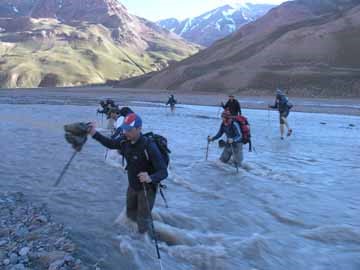
River crossings en-route to Aconcagua Base Camp.
You will be expected to display a level of self-sufficiency at the high camps. People who feel insecure and uncertain will generally exhibit quite wayward and often startling changes of character; they can become withdrawn, moody, angry, upset, and distraught. None of this is good for anyone, so be prepared for potentially extreme situations at the high camps and don’t start the trip believing that the guides will do everything.
The base camp facilities are fantastic. A tented city with showers, bars, toilets, double walled mess tents with wooden floors, amazing food, lots of people to meet...it’s also noisy, often dirty and absolutely full of people in the high season. If you want mountain solitude, then you won’t find it at Plaza del Mulas or Plaza Argentina. This is a very busy place and it can get a bit overwhelming. Once up high you do get more of the sense of being out in the mountains though.
Illness is common, and predominantly because of a combination of high altitude symptoms and some small issue like a cough or a bit of diarrhea. Remember that being at altitude is essentially like hypoxia to your system, so anything you get will be affected to a greater degree up there. It’s absolutely vital to stay as healthy as possible, keep clean and go slowly.
The toilets are metal long drops, perfectly acceptable, but don’t expect a sit-down affair, and don’t expect it to be heated. In the morning, crouched freezing over a hole that has been missed by the last person, and with a queue of people standing outside, it’s not the most pleasant experience. Up high, you make your own toilet area and carry all your waste and paper off the mountain. This is perhaps one of the worst aspects of the descent when the sun is up and the contents have liquefied. Take lots of non-clear plastic bags and wrap it well.
Going to the summit even in good conditions is a real test of physical and mental reserve. It’s not a walk in the park by any means. The route is not difficult to follow unless you end up in a whiteout in which case the huge slope below the Independencia Hut can be a nightmare to find your way off, but it is unrelenting and the wind whips across continually. Once you are at the base of the Canaleta, it’s tempting to think that you’re nearly there. In terms of distance and height gain, you are, but it’s still a lot of hard work going straight up the mess of rocks and snow, traversing the final bowl and scrambling up the top. The one saving grace is the simply astounding view of the South Face in the last half hour or so, which would give anyone a major emotional boost.
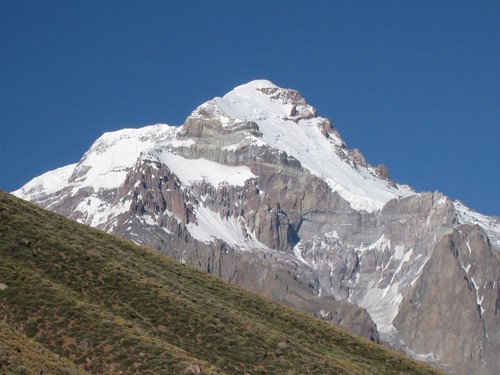
Mount Aconcagua as seen from Vacas Valley.
Remember to keep strength in reserve for the descent, it is a long way back to the tent and the weather may well have picked up in the afternoon; make sure you have supplies of food and drink and get a warm tea or coffee in there, and something to eat. A lot of people come back down in a state of near exhaustion, which might be fun to relate when you’re back in the bar at home, but no mountain guide would consider that to be a badge of honour. You come down with energy to spare, mind lucid, ready to put the water on to boil, and feeling nicely tired after a big day out.
Aconcagua has been described by some detractors as a great big slag heap with nothing really to say for itself, apart from being the highest peak in South America. Clearly, this is a subjective opinion, but whatever the case, don’t let such comments diminish the size of the mountain and the potential danger up there. It’s always easy to criticise things, but this is not an expedition to underestimate.
See more information on Facts about visiting Argentina and preparation for climbing Aconcagua.
Dates & Bookings
Itinerary
MOUNT ACONCAGUA ITINERARY
The expedition is 19 days in-country, but this does not include flight times or extra days in-country. Many people choose to arrive a day or so early to acclimatise to the climate and overcome the long flight, and of course some people stay on afterwards to visit the vineyards and enjoy the area round Mendoza.
Vacas Valley Aconcagua itinerary
| Day No | Activity | Meals |
| Depart UK | ||
| 1 | Advertised Climb Date: Team arrive, Hotel | dinner in Mendoza |
| 2 | Get permits am, rest | Mendoza |
| 3 | Transfer to Mountain | Depart midday, camp near park gate |
| 4 | Pampa de Lenas | Breakfast, Pack lunch, Camping dinner |
| 5 | Case de Piedra | Breakfast, Pack lunch, Camping dinner |
| 6 | Plaza Argentina | Pack lunch, BC dinner |
| Day 7 - 16 | Climbing period | |
| 17 | Walk to Pampa de Lenas | Breakfast in BC, packed lunch, Hostel meal |
| 18 | Walk to gate, bus to Mendoza | Meal out |
| 19 | Depart Mendoza |
Vacas Valley suggested climbing period plan
| Day No | |
| 7 | Casa Piedra to Pl Argentina |
| 8 | Carry to C1, back to BC |
| 9 | Rest day |
| 10 | Carry to C2, back to BC |
| 11 | Rest day |
| 12 | C1, overnight |
| 13 | C2, overnight |
| 14 | Camp Colera or possible summit from C2 |
| 15 | 1st summit day |
| 16 | 2nd summit day |
| 17 | BC, out |
| 18 | BC to Pampa de Lenas |
Horcones Route Aconcagua itinerary
| Day No | Activity | Meals |
| Depart UK | ||
| 1 | Advertised climb date: Team arrive, Hotel | dinner in Mendoza |
| 2 | Get permits am, rest | Mendoza |
| 3 | Transfer to Mountain | Depart midday, camp near park gate |
| 4 | Camp Confluencia | Breakfast, Pack lunch, dinner |
| 5 | Camp Confluencia - visit to Plaza Francia | Breakfast, Pack lunch, Camping dinner |
| 6 | Plaza de Mulas | Pack lunch, BC dinner |
| Day 7 - 16 | Climbing period | |
| 17 | Walk down valley, transport to Mendoza | Breakfast in BC, packed lunch, Hostel meal |
| 18 | Travel to Mendoza | Meal out |
| 19 | Depart Mendoza |
Horcones route suggested climbing period plan
| Day No | |
| 8 | Plaza de Mulas rest day |
| 9 | Acclimatisation to Camp Canada 5000m |
| 10 | Acclimatisation to Nido de Condores, 5500m |
| 11 | Rest day |
| 12 | Weather day - potential carry to Nido |
| 13 | Overnight at Nido de Condores |
| 14 | Overnight at Berlin or Colera Camp |
| 15 | Summit day |
| 16 | Summit day |
| 17 | Descent to Base Camp |
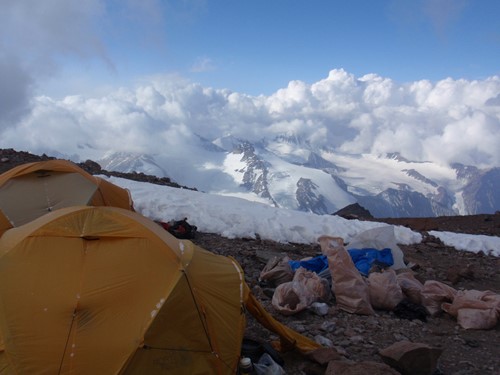
The nearest airport to Aconcagua
You need to get to Mendoza in Argentina.You can fly there with a number of variations, via Santiago, Buenos Aires or Sao Paulo being the main nearest hubs. Airlines which serve the route include LanChile, TAM Brazil, Iberia, Air France and British Airways. Flights can become very expensive s st to to book early.
Another option if you have the time is to fly to Santiago and take a coach across the Andes to Mendoza which costs about £30.00 each way. Long distance coaches in South America are very comfortable, the semi cama class has a seat which lies flat to make a bed and the ticket includes meals. The journey begins in the main bus terminal in Santiago and there are many coaches which drive the trans-Andean Highway that passes Aconcagua on the way to Mendoza.
Arriving in Mendoza
Arriving in Mendoza you will need to take a taxi to the hotel we have allocated. The journey is about 20 minutes by cab and will cost no more than about 35 pesos. It's a nice hotel, close to the city centre, and we use twin rooms unless you specify single rooms on your booking.
Feel free to arrive a few days earlier to enjoy the beautiful city of Mendoza. You can also travel an hour outside the city to Vallecitos and do some preparatory hiking in the Cordon del Plata which is a popular skiing and hiking area with refuges to stay in. A three day visit could get you up to 4500m+ and stretch the legs before the expedition to Aconcagua.
Our staff will meet you at the hotel and talk you through the preparations for the trip. Hopefully you will have met online before the trip, and perhaps even met one another. We do offer training weekends either in the UK or in the French Alps, where teams can do a specific programme which will prepare them for Mount Aconcagua. Please contact us for details.
There are so many restaurants to choose from, but we recommend a wonderful place called Caro Pepe, which is a buffet grill that sells all types of Argentinian meats and specialities. The meat is cut right off the parilla, and there is wonderful wine too.
Aconcagua National Park rules
You will have to pay a fine of between $100 and $200 if you:
* Do not use the toilets provided by the park.
* Throw rubbish on the paths in the park
* Leave or do not use the numbered rubbish bags provided by the park.
* Pollute rivers, streams or waterfalls.
* Damage wildlife, plants and natural, cultural or archaeological features which are protected
* Gather or burn wood in the park.
* Carve inscriptions in the stones.
On matters of poop’n’scoop
When arriving in Plaza de Mulas or Plaza Argentina, the Ranger will register you and hand over a numbered "shit-bag." This bag will be your companion all the time on the higher reaches of Aconcagua and if you lose it you have to pay a USD$200 fine. You're supposed to use the bag as the only alternative for a toilet and if you're doing your business without it and are spotted by the guards there is a $100 fine.
Be warned, the plastic of the bag is not that thick and is not to be trusted. Double or triple pack it with large sealable freezer bags in order to avoid disgusting leakage in your backpack. At the end of the trip, you will have to hand in the bag to the base camp services company. At base camp, there are good toilets to use however so these bags are not necessary. Don’t forget that at altitude you tend to dehydrate and use a large number of calories, while probably eating less than you do at home. So, therefore, you tend to go to the toilet less. You will need to bring some toilet paper which also needs to be bagged.
At the high camps, people generally find a boulder to go behind for going to the toilet.
Cost
Mount Aconcagua cost £3395.00
Price is based on minimum group size of 4. There are certain items on the trip which are paid in cash locally, either in US dollars or Argentinian pesos or with a credit/currency card. Please see the inclusions and exclusions and notes below.
Included
- Mountain Leader services and and mountain leader assistants based on a ratio of 1:5
- Transport bertween Mendoza and Puente del Inca and the National Park gate
- Mules for carrying the gear to base camp and back
- Tents, cook sets, stoves and ready meals for the high camps (see note below)
- Meals at Base Camp
Excludes
- International airfare to Mendoza
- Hotel in Mendoza and in Puente del Inca
- Climbing permit for Aconcagua - see below
- Meals in Mendoza and in Puente del Inca (estimate USD$30 for a dinner with drinks)
- Personal equipment and expenses
- Medical/Evacuation insurance
- Porters from base camp to the high camps and back down
Notes
Group equipment - some is carried out to Argentina by the team, we generally try to meet at the airport or if necessary we courier equipment to you. It's important to leave a few kilos and space available in your bag for carrying some group kit out with you. Normally this comes to 5-6kgs per person.
Food is bought by the team in the supermarket in Mendoza before we leave for the mountain. These are snacks and beverages for five nights at the high camps. The main ready meals are bought by us and either carried out in luggage or bought locally in Mendoza.
Hotel rooms will be booked by us but payment of the rooms plus any room costs like meals, drinks etc to be paid by yourself on checkout. Or you can book a room yourself online.
Peak permits must be applied and paid by you in person at the provincial park office in downtown Mendoza which is only open from 8am to 6pm on weekdays but 9am to 1pm on weekends. Payment is made in dollars cash by each individual to a local bank, a receipt is taken and then the permit issued. The cost depends on the route and the season and the current figures are as follows:
Normal route (Horcones) High season $820, Low season $600
Polish route (Vacas) - High season $970, Low season $750
Low season is 1st November - 14th December and 1st Feb to 30th April.
High season is from 15th December to 31st January
Porters are available at base camp and can be arranged and paid according to the camp being reached. People often share a porter to carry group items like fuel, food and tents. Normally people spend about $150 each for a carry to Nido de Condores and back down again.
Money needed in country
Permit - USD$820.00 in cash
Hotel - for 3 nights in a twin share room is about $170.00. Can be paid on currency or credit card or in dollars or pesos.
Meals - in Mendoza and Puente del Inca estimate $30 for a lunch or dinner with drinks
Porter - estimate $150 for a carry to the high camp and back down for some personal gear on a shared basis
Hot showers - $15 at base camp
Flights
Arrival point is Mendoza in Argentina and there are multiple ways of getting there. Popular routes are via Lisbon or Paris and then to Buenos Aires.
Total cost of the trip
Adding up flights from the UK, trip insurance, mountain permit, hotel and meals for 3 days, personal expenses at base camp, a share of a porter and land costs to Adventure Alternative the average cost of this trip normally comes to around £5800.00.
Payment to us
We ask for £250.00 minimum deposit when you book. You can make instalments and we ask that 50% of the trip fee is paid by four months prior to the trip, and the total paid six weeks prior to the date of departure.
We recommend you get your travel insurance in place as soon after booking as possible, and ensure it is the correct policy for a non-technical climb to 7000 metres.
We use a local company to provide the mules for equipment and also the base camp meals and porters. They provide food and accommodation sites including breakfasts, lunches and dinners and a mess tent with toilets at the base camp.
Kit List
Mount Aconcagua Kit list
- Rucksack (80L) and a day sack if you wish
- Large duffle bag to go on the mules
- Bag to leave clothes in hotel
- Selection of dry bags
- Sleeping bag rated to -20c, 4 season, preferably down (optional liner or bivi outer)
- Thermarest or foam sleeping mat, full length
- Headtorch with spare batteries and bulbs
- Water bottles & insulating covers, and flask for hot drinks
- Pee bottle
- Insulated cup with lid, spoon and fork
- Toiletries: wet wipes, towel, hand gel, nailbrush, soap, toothbrush and paste, shaving kit, soap, toilet paper, shampoo
- Sunglasses, suncream and lipcream (spf high factor), moisturising cream, aftersun
- Repair kit: cable ties, laces, wire, small pliers, string, gaffer tape, superglue, penknife
- First aid kit: plasters, aspirin, ibuprofen, general antibiotic, throat lozenges, Paracetamol, bandages, plus medicines for diarrhoea, gastric problems and coughs. Acetazolamide (also known as Diamox, please read our section on this drug in Health on a High Altitude Trek and Acclimatising Safely electrolyte rehydration sachets, antiseptic cream or liquid, personal medications.
- Map of Aconcagua (ISBN 9783952329405 or 187956811X or 9783952329405) and compass
- Altimeter or GPS (optional but very useful), see GPS co-ordinates in Horcones Route
- Walking axe
- Crampons
- Plastic mountaineering boots e.g. Scarpa Vega, or good quality hybrid double boots
- Trekking boots for the walk in and sandals for base camp
- Trekking poles
- Goggles or sunglasses with sideguards and interchangeable yellow/orange lenses for flat light
- Inner liner gloves and thick outer gloves, and warm mitts
- Fleece hat and sunhat
- Balaclava, neck warmer or scarf
- Trekking socks and high quality thick climbing socks for high camps
- Gaiters, useful in deep snow and for warmth around the lower leg
- Shorts and t shirts, hiking trousers and shirts
- Base layer, top and bottom
- Fleece mid layers
- Fleece jacket, good quality
- Windproof 'shell' trousers and jacket
- Down jacket with hood, good quality (not 'street style' down jackets)
- Camera, batteries or small solar charger, diary, pen, books
RENTAL ITEMS
You can hire all the equipment you are likely to need in a rental shop in town, there are many to choose from but we like to use one called Limite Vertical on Sarmiento Street.
It is worth pointing out that the supermarkets sell everything you may need in terms of personal stuff for your washkit, sweets and snacks and any types of food. This might save you a lot of weight in your baggage.
Aconcagua books and maps
Below is a list of additional resources for planning your trip to Aconcagua.
Altitude and its Effects
Travel at High Altitude, Medex, ISBN 0-901100-76-5 (free to download)
Altitude Illness: Prevention & Treatment, The Mountaineers Books, Bezruchka, ISBN 0-89886-685-5 (pocket sized guide)
Medicine for Mountaineering, The Mountaineers Books, Wilkerson et al, ISBN-10: 1594850763, ISBN-13: 978-1594850769
British Mountaineering Council (BMC) website advice
International Mountaineering and Climbing Federation (UIAA) website advice
UIAA Aconcagua Climb medical advice article
Full UIAA medical resource download (3.5Mb Zipped folder, 22 Chapters)
Aconcagua Region Guides
Aconcagua & the Southern Andes, Cicerone, ISBN-10: 1852845872, ISBN-13: 978-1852845872
Aconcagua: Summit of South America, Rucksack Readers, ISBN-10: 1898481512, ISBN-13: 978-1898481515
Aconcagua: A Climbing Guide, Mountaineers Books, ISBN-10: 0898866693, ISBN-13: 978-0898866698
Argentina, Lonely Planet, ISBN-10: 1741794641, ISBN-13: 978-1741794649
The Rough Guide to Argentina, Rough Guides, ISBN-10: 1848365217, ISBN-13: 978-1848365216
Map of Aconcagua
Aconcagua, 1:100 000, Aoneker/Meridies, ISBN 13: 9789871484140
Aconcagua, 1:50 000, Aoneker/Meridies, ISBN 13: 9789871484133
Aconcagua, 1:50,000, Zagier y Urruty, ISBN 10: 187956811X, ISBN 13: 9781879568112
Cerro Aconcagua climbing and trekking map, 1:40,000, ISBN 13: 9783952329405
Aconcagua, 1:42,230, JLM Mapas
Climbing and Mountaineering
Mountains of the Mind: a History of a Fascination, Robert Macfarlane, Granta Books, ISBN-10: 1847080391, ISBN-13: 978-1847080394
Mountaineering in the Andes, Neate, Hyperion Books, ISBN-10: 0907649645, ISBN-13: 978-0907649649 (view free online at RGS website)
Seven Summits, Bass, Gramercy Books, ISBN-10: 0517227509, ISBN-13: 978-0517227503
Five Big Mountains: A Regular Guy's Guide to Climbing Kilimanjaro, Aconcagua, Vinson, Elbrus, and Orizaba, Mercer University Press, ISBN-10: 0881462101, ISBN-13: 978-0881462104
Photos
Choose a scheduled date or contact us to set up private dates or a bespoke itinerary. The minimum deposit is £100.00 and the balance is due four weeks before travel.
Myself and 2 friends undertook a trip to Aconcagua in February 2017 with Adventure Alternative. At the time of booking t…
Read More James Cooper- Duration 20 days
- Numbers 5- 15
- Altitude 6962 metres
- Distance 60 kms
- Challenge Strenuous
- Comfort Camping



